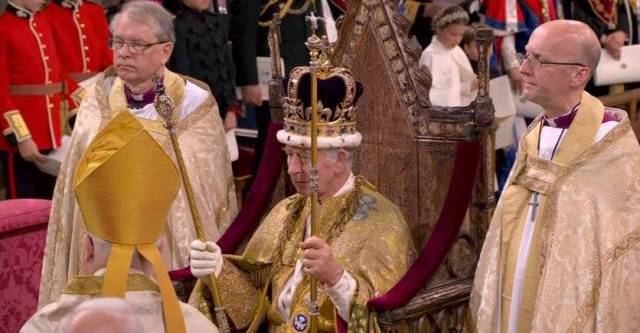 6th May, 2023: The Coronation of King Charles III at Westminster Abbey. [photo: live TV]
6th May, 2023: The Coronation of King Charles III at Westminster Abbey. [photo: live TV]
[This is an excerpt from an article in The Round Table: The Commonwealth Journal of International Affairs.]
Coronation and the law of succession in the Realms
What of the Realms? Again, Charles became King of the 15 different Realms upon his mother’s death, without any action on the part of a Realm (although there were various accession declarations, including in Australia at the Commonwealth and State levels). But how the succession occurred, as a matter of law, has been treated differently in the various Realms.
Originally, the rules of succession to the throne, which are found in a mix of common law inheritance rules and various statutes, such as the Bill of Rights 1689 and the Act of Settlement 1701, were British laws only and governed one indivisible Crown. However, those laws also applied as part of the law of the various colonies, initially as laws of paramount force. This meant that they overrode any local law of the colony. But as the Crown became divisible, so too did the rules of succession to the Crown. In Australia, those British laws that had become part of Australian law ceased to apply by way of paramount force and could be locally amended. This occurred from the adoption of the Statute of Westminster 1931, which occurred in Australia in 1942 and was back-dated in its application to 1939.
A 21st Century coronation
The coronation of King Charles III: An occasion for worldwide celebration
Opinion – The coronation of King Charles III: An Australian perspective
The Coronation and the Commonwealth
Moreover, the effect of the Australia Acts 1986 (Cth) and (UK) was that any change to the British laws of succession would not affect the law in Australia about succession to the Crown of Australia. That meant that when the rules of succession were changed in 2015 so that they no longer favoured males over females and so that persons who married Catholics were no longer excluded from succession, this change was made in Australia by local law. As the Commonwealth Constitution does not directly give the Commonwealth Parliament power to change the rules of succession to the Crown, resort was had to s 51(xxxviii) of the Constitution. It permits the Commonwealth Parliament to enact a law – in this case the Succession to the Crown Act 2015 (Cth) – at the request and with the consent of every State Parliament, if it is a law for the exercise of a power which at the time of federation could only have been exercised by the Parliament of the United Kingdom. So for Australian purposes, it is Australian law which controls who succeeds to the Crown of Australia, even though Australia has chosen to keep that law consistent with the equivalent British laws.
Canada, in contrast, was not prepared to undertake an equivalent federal process of reform, due to concerns about Quebec. The consequence is that the Canadian Government decided to take the view that whoever is monarch of the United Kingdom is automatically King or Queen of Canada, with Canada having no say in it. So if the British Parliament passed a law tomorrow to make Boris Johnson King of the United Kingdom (remembering that his childhood ambition was to be King of the world), he would automatically and immediately become King of Canada, but he would not become King of Australia unless all State Parliaments and the Commonwealth Parliament enacted a law to make him King (subject to any contrary interpretation of covering clause 2 of the Constitution by the High Court).
Other Realms have taken varying positions on whether it is UK law or their local law which determines who is their King. But the one uniform aspect is that the heir becomes the new monarch immediately on the death of the previous monarch – it is not the coronation which makes the transformation.
A British Coronation or a Coronation for all the realms?
While the Coronation may have no legal effect in relation to the Realms, does it still purport to crown Charles as King of the various Realms, or is it solely a British Coronation?
This proved to be a difficult question once the Crown became divisible, but even before then, from the beginning of the 20th century, efforts were made to include the Dominions (later Realms), at least symbolically, in the ceremony.
It started in a small way, with standard bearers for South Africa, New Zealand, Australia, Canada and India being included in the Coronation procession of King George V in 1911, before the Crown had become divisible. Their involvement was largely a show of the extent of the Empire, adding to the prestige and power of the Crown.
Anne Twomey is Professor Emerita in Constitutional Law, University of Sydney, Australia.



